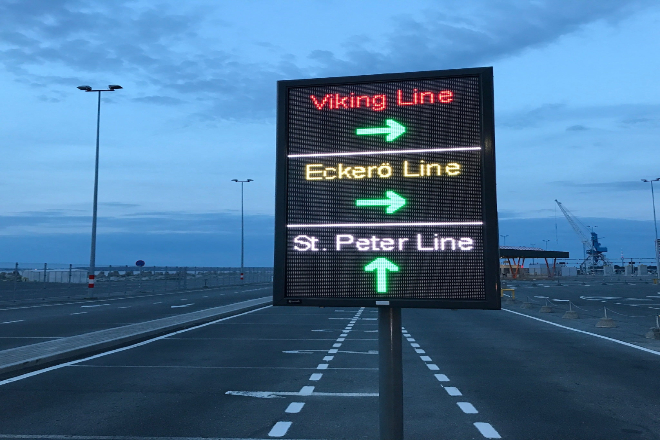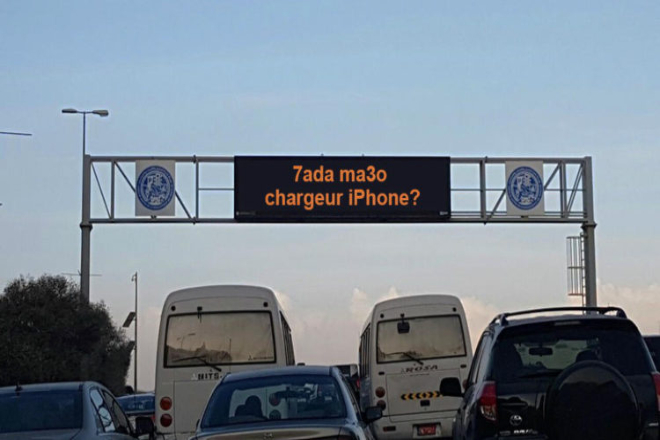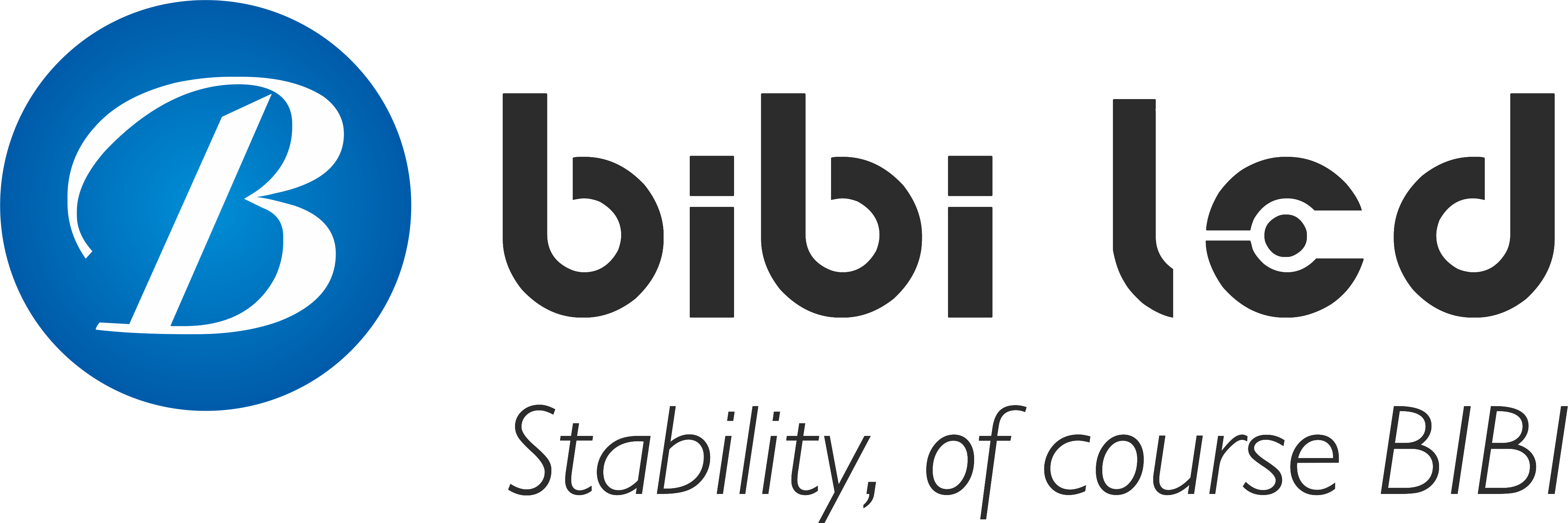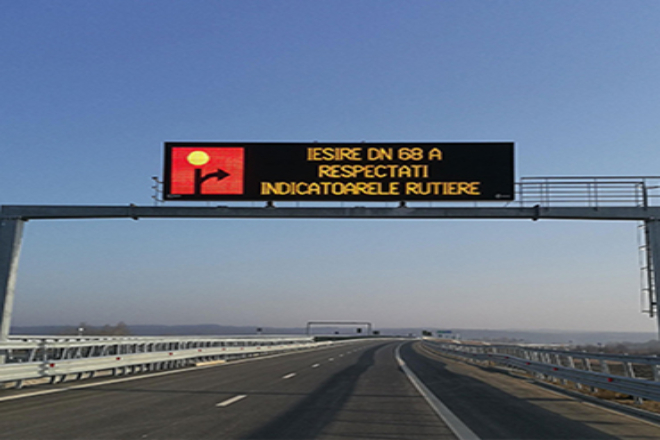介绍
目录
1、LED显示屏在交通指挥方面有哪些优势?

LED显示屏的亮度非常高,即使在户外阳光直射的情况下,驾驶员和行人也可以轻松地看到屏幕上的信息。
例如在交通路口,显示屏可以清晰地显示路况、限速提示、安全警示等内容。
这种高亮度、高对比度的显示效果保证了信息传输的准确性和可靠性。
试想一下,在烈日下,普通显示屏可能会反光或者看不清楚,但LED显示屏却可以让你看得清楚,这对于交通安全至关重要。
LED显示屏可以实时更新交通信息,这是它的亮点之一。
例如,交通管理部门可以通过后台系统随时更新前方道路是否拥堵、是否有事故、是否有施工等信息。
在行驶过程中,驾驶员可以通过这些显示屏提前了解路况,选择最佳路线。
这种实时性使得交通信息更有价值,并减少了驾驶员因信息滞后而陷入交通拥堵的可能性。
LED显示屏不仅可以显示文字信息,还可以显示图形、动画。
例如,可以使用箭头指示车辆的方向,或者使用动画来显示复杂的交通规则。
这种多样化的显示方式使得驾驶员和行人更容易理解信息。
例如,在复杂的路口,动画箭头可以直观地告诉驾驶员应该往哪个方向行驶,减少因误解交通规则而造成的困惑。
LED显示屏通过显示实时路况和交通提示,可以帮助驾驶员提前调整路线,避开拥堵路段。
这一功能在交通高峰时段尤为重要,例如在城市主干道上,显示屏可以引导车辆选择不那么拥堵的路线,从而提高整体的交通效率。
这对于缓解城市交通压力,使驾驶员的出行更加顺畅有很大帮助。
LED显示屏可以显示“减速慢行”、“注意行人”、“学校区域”等安全提示,提醒驾驶员注意安全。
这些提示在特定区域尤其重要(例如学校附近、 医院、施工区域等),可有效减少交通事故的发生。
例如,在学校附近的路口,LED显示屏可以显示“学校附近,减速慢行”的提示,提醒驾驶员减速并注意行人安全。
LED显示屏能在高温、低温、潮湿等不同环境条件下稳定工作。
这意味着无论天气如何变化,显示屏都能持续提供准确的交通信息。
比如北方的冬天,气温特别低,很多设备容易出现问题,但是LED显示屏却依然可以稳定工作,保证交通信息的传输不受影响。
交通管理部门可以通过网络对LED显示屏进行远程控制和监控,实时更新信息,监控设备状态。
一旦发现问题,可以迅速安排维修,确保设备正常运行。
这种远程控制功能使交通管理更加高效,并减少了人工检查的频率和成本。
LED显示屏通过实时显示路况,可以帮助驾驶员提前避开拥堵路段,有效缓解交通压力。
在城市主干道或高速公路上,这种实时路况的显示可以显著增加交通流量,减少拥堵时间。
这对于提高城市交通整体运行效率、使驾驶员的出行更加顺畅有很大帮助。
LED显示屏可以与智能交通系统相结合,实现交通信息的自动采集和显示。
交通管理部门可以根据实时数据调整交通规则,提高交通管理的智能化水平。
例如,LED显示屏通过与交通监控摄像头、传感器等设备集成,可以实时显示道路状况、交通流量等数据,帮助交通管理部门更好地管理交通,提高城市交通整体运行效率。
2、LED显示屏在交通指挥中心的应用
1). 交通数据的可视化呈现
想象一下,交通指挥中心就像一个“交通大脑”,而LED大屏幕就是这个大脑的眼睛。
可以使各种复杂的交通数据变得简单易懂,让工作人员一看就明白。
例如,道路流量热力图就像一张彩色地图;绿色表示畅通无阻,黄色表示有点慢,红色表示非常拥堵。
当工作人员看到红色区域时,他们就知道哪里拥堵,并且必须迅速处理。
还有速度分布图,可以显示道路不同路段的车辆速度。
如果发现某个地方的车辆速度突然减慢,那么可能存在问题。
再比如拥堵指数曲线,它就像一条波动的线,可以告诉工作人员拥堵情况是如何变化的,是越来越拥堵,还是慢慢缓解。
通过这些直观的显示,工作人员可以快速发现问题、做出决策并使交通更加顺畅。
2). 监控图像的整合与切换
在交通指挥中心,LED屏幕就像一台“超级监视器”,能将众多摄像头的图像集中在一个大屏幕上。
这些摄像头分布在各个重点路口、路段、交通枢纽,就像多双眼睛注视着交通状况。
工作人员可以在大屏幕上同时看到多个地方的情况,无需来回切换,就能全面掌握实际的交通状况。
而且,如果某个地方出现问题,比如发生交通事故或者有人违反规则,工作人员就可以迅速切换到该摄像头的画面,仔细检查情况。
大屏幕还可以将多幅画面拼接在一起,形成更大的视角,让工作人员看得更清楚。
这样,就能及时发现和处理各种突发事件,减少事故、违法行为造成的拥堵。
3).应急指挥与协同调度
当遇到交通事故、道路施工等交通突发事件时,LED大屏幕就成为指挥中心的“指挥棒”。
它可以实时显示应急响应计划,告诉工作人员应该做什么,比如先做什么,后做什么,哪些步骤不能错过。
同时,大屏幕上还能看到交警、路政、消防、医疗等各部门的位置和状态,宛如一张“救援地图”。
根据这些信息,工作人员可以快速部署救援力量,并让各个部门协同工作。
比如,交警首先去疏导交通,消防、医疗救援第一时间赶赴救援,路政部门去疏通道路。
大屏幕上还会显示哪些地方封闭、哪些地方限速等交通管制措施,以便各部门及时调整行动。
通过这些信息的共享,各部门可以快速做出反应,尽快恢复交通秩序,减少拥堵给大家带来的影响。
4). 决策支持与分析
LED大屏幕不仅是“眼睛”,更是“智囊团”,可以与客流分析软件配合,对历史数据和实时信息进行分析,为工作人员提供有用的建议。
比如,它可以预测交通流量,告诉工作人员哪些路段可能会出现拥堵,并提前做好准备。
它还可以分析拥堵趋势,让工作人员知道拥堵情况是加剧还是缓解。
LED大屏幕还会提供信号配时的优化方案,就像一个智能的“交通指挥官”,告诉工作人员如何调整信号灯的时间,让路口的交通更加顺畅。
有了这些决策支持,工作人员可以提前采取措施缓解拥堵,使整个交通系统更加高效地运行。
3、LED显示屏在城市道路的应用
1). 路口诱导屏
在城市的主要路口,LED诱导屏就像一个“交通指南”,它会以直观的图标或文字显示当前路口的拥堵情况,并告诉你路况是否畅通。
例如,它可能会显示红色的“拥堵”或绿色的“畅通”,以便您一眼就能了解路况。
它还将显示预计的行驶时间,告诉您通过路口需要多长时间。
更重要的是,它会像智能导航系统一样推荐周边地区的替代路线。
当你接近路口时,可以看到诱导屏上的信息,根据实际情况及时调整行驶方向和路线,避开拥堵路段。
这样,整个路网的车流量就能更加均衡,道路的通行能力就会提高,大家的出行也会更加顺畅。
2). 路段信息屏
在城市主干道、高速公路等路段两侧,LED信息屏就像一个“道路信息播报员”,它会发布实时路况,告诉你前方道路是畅通还是拥堵,有没有事故发生。
如果有道路施工,它会提前通知您,以便您准备减速或变道。
交通管制公告也会及时发布,比如某路段限行,会告诉你如何绕行。
还有天气警告,例如大雨和大雾,提醒您安全驾驶。
驾驶员在驾驶过程中看到这些信息,可以提前做好应对措施,合理安排出行计划,减少突发事件造成的停车、减速,保持交通畅通,避免因突发情况造成混乱。
3). 公交车专用LED显示屏
公交专用道上的LED显示屏可以说是公交车的“智能助手”,它会显示公交车的实时位置,让你知道公交车还有多长时间才能到达站台。
到达时间也会准确显示,方便乘客合理安排候车时间,不会白白等待。
车辆载客量也会显示出来,比如告诉你这辆公交车是否已经拥挤,你可以选择等待下一班车。
这些信息提高了公交车运营的透明度和可靠性,让乘客感到乘坐公交车更加便捷、可靠。
这样,更多的人就会愿意选择公共交通,减少私家车的使用,从而缓解交通拥堵的压力。
同时,这也有利于提高公共交通车辆的运营效率,优化城市交通结构,使城市交通更加绿色高效。
4、LED显示屏在高速公路交通中的应用

1). 高速公路信息牌
在高速公路上,LED信息牌就像是驾驶员的“千里眼”,当你在高速公路上行驶时,你可能并不知道前方道路的情况,但信息牌会告诉你。
比如会显示前方道路是否畅通、是否发生过事故、事故的严重程度等,以便你提前做好准备,提前减速或者变道。
如果前方有施工,信息板也会提前通知您,告诉您施工的具体位置和预计结束时间,以便您了解。
信息板还会显示服务区的位置,包括距离下一个服务区还有多远,服务区内是否有加油站、餐厅、卫生间等设施,这对于长途驾驶的司机来说尤其有用。
另外还会显示收费标准,让你提前知道需要支付多少费用,避免在收费站手忙脚乱。
有了这些信息,司机可以提前规划行程,选择合适的路线和服务区,避免因信息不及时或不准确造成的交通拥堵和延误。
同时,高速公路管理部门还可以通过信息牌及时发布交通管理和安全提示,如恶劣天气预警、限速调整等,保障高速公路安全畅通。
2). 收费站LED显示屏
在收费站,LED显示屏就像一位“智能交通指挥官”,实时显示通行费率,让你在进入收费站前就知道自己需要支付多少,并提前准备找零或调整付款方式。
LED显示屏还会显示车道开启、关闭信息,告诉您哪些车道正在使用,哪些车道暂时关闭,以便您提前选择顺畅的收费车道,避免在收费站前排队。
LED显示屏还会显示车流量,如果某个车道的车流量特别大,可以提前切换到车流量较小的车道,减少等待时间。
有了这些信息,驾驶员可以在进入收费站前及时获取相关信息,提前做好准备,选择畅通的收费车道通行,减少车辆的等待时间,提高收费站的通行效率,避免因收费问题造成的交通拥堵。
同时,收费站工作人员也可以通过显示屏更好地管理收费工作,及时调整车道使用情况,保证收费站的高效运转。
通过这些LED显示屏的应用,高速公路交通的管理变得更加智能、高效,不仅提高了道路的通行能力,也改善了驾驶员的出行体验,使高速公路交通更加顺畅、安全。
5. 结论
LED显示屏在交通指挥中的应用,为解决交通拥堵问题带来了新的希望。
从交通指挥中心的数据可视化,到城市道路的实时路况提示,再到高速公路交通的智能诱导,LED显示屏正以其独特的优势逐渐改变我们的出行体验。
最后,如果你想了解更多关于LED显示屏的信息, 请与我们联系。
您可能感兴趣:
Other articles about LED displays in transportation:

